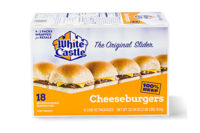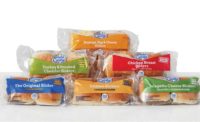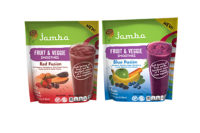To keep up with demand for its retail frozen food offerings, White Castle opened a new 80,000-square-foot, LEED Gold-certified frozen food manufacturing facility in Vandalia, Ohio.
For many consumers, a burger is just a burger. But, for White Castle’s loyal fans, it’s the 5-hole technology that makes this Columbus, Ohio-based company king of fast food. So, in 1987, it brought its coveted hamburgers and cheeseburgers into the retail channel. Since then, the White Castle cheeseburger reigns as the No. 1 selling frozen sandwich in retail stores and vending operations across the country, according to Nielsen, total frozen appetizers and sandwiches, ended Oct. 4, says Rob Camp, vice president and general manager.
Fast FactsCompany: White Castle Plant Location: Vandalia, Ohio Produces: 57 million sandwiches a year Total Square Feet: 80,000 Distribution: Nationwide and beginning into Canada No. of Employees: 80 No. of Processing Lines: 1 No. of Packaging Lines: 1 Certifications: SQF Level 2, HACCP |
That’s why White Castle built a $19.4 million production facility in Vandalia, Ohio. This LEED Gold-certified plant is home to one production line that produces nearly 3.5 million pounds of USDA-inspected raw ground beef into sandwiches, close to 800,000 pounds of rehydrated onions and adds nearly 1 million pounds of cheese to its burgers a year, equally close to 16,500 burgers per hour or over 220,000 sandwiches a day.
“Really what we’re doing here [at the Vandalia facility] is duplicating what happens at White Castle restaurants,” says Brad Rife, assistant vice president of operations. “We have to put onions down, then we slice the meat, then we put the bun bottom on top of the ground beef, then we cook the product and then put the cheese on it and the bun top.”
It’s this continued growth and ability to revamp the burger industry that deems White Castle as Refrigerated & Frozen Foods’ 2014 Frozen Foods Processor of the Year. Take a tour of this 80,000-square-foot facility (with an additional 75,000 square feet to expand) and find out why this plant is different—and more energy efficient—than its two other frozen food manufacturing sites.
The power of automation
At the time of Refrigerated & Frozen Foods’ visit, the Vandalia facility was producing cheeseburger Sliders, operating two shifts of production on one line five days a week with a cleaning/maintenance shift overnight.
Frozen ground beef comes in 25-inch-long logs from one of the company’s three meat processing facilities— Zanesville, Ohio; Orleans, Ind.; and Lebanon, Ind.—and then is stored on racks in the 25°F tempering room for 3-4 days. The meat ships already extruded using the 5-hole technology, which prompts a faster way to cook the patties (steam rises through the holes, cooking the patty all the way through).
After the meat has tempered, operators place the racks on a hoist that raises up to the operating level, so they can be manually loaded into the meat slicers. About 16 logs of meat are sliced at one time.
Once the patties are sliced, an onion dispenser, which consists of two grates that rub together to drop about 5 grams of onions on each burger, drop onions on to grill plates set at 150-160°F. Then, the meat is sliced on top of the bed of onions, 16 burgers at a time. In the onion rehydration room, 75 pounds of onions are dumped into a large bin mixed with 210 pounds of water, then vacuumed and tumbled for 10 minutes before use. Meanwhile, an infrared heater pre-cooks the tops of the sandwiches.
“It’s kind of our insurance policy,” Rife says. “We do not want anything raw leaving our plant, so we cook it well above what we need to.”
Then, a seasoning dispenser drops a pre-set volume of salt and pepper spices on to the burgers before they meet up with bun bottoms, which are placed on top of the ground beef. After the bun bottoms are put onto the ground beef patties, the product passes over a set of burners that fully cook the product exactly like one would find in a White Castle restaurant.
“It’s this ‘steam-grilled’ process that locks in that one-of-a-kind White Castle taste,” adds Rife.
Logs of cheese are shipped in similar fashion to how the frozen ground beef comes in, and are placed into a similar slicer to be cut 16 at a time, then automatically dispensed on to the burgers.
Moving over to the cooked side of the facility, product moves down the 65-foot conveyor, while the top buns convey in from the bun room—that runs perpendicular through a heavy mil, crystal clear, USDA-approved curtain that separates the raw from the cooked areas—to meet up with the conveyor transporting the burgers.
“In the bun prep area, operators place 48 top buns onto a sheet, then slices them and separates them before conveying them to where they will be placed on the line,” Rife says. “Our grill operators are serving both a production and QA function, making sure only quality product makes it to further processing.”
The burgers then continue to convey into an automatic wrapper that wraps two burgers into one clear plastic film that is then code dated for traceability purposes. An operator then inspects each 2-pack to make sure it meets White Castle’s stringent food safety and quality specifications.
“This is the last line of inspection before the product goes behind the wall into the freezer,” Rife adds. “Operators make sure that the product is sealed, that it has all of its parts, that there’s nothing wrong with it, etc.”
Once the product has been deemed good to go, it conveys into the -30°F freezer and travels up 24 feet and down a corkscrew slide that loops down through a metal detector and into the packaging room. Product exits the spiral freezer frozen solid.
In the 8,000-square-foot packaging room, product travels over a checkweigher, underneath a laser coder and is then manually packaged in a carton before being automatically sealed and sent into freezer storage, which is set at -10°F and holds 600,000 racks.
“Right now, our packaging room is not automated, but we have plans to automate it and add more lines in the future,” says Rife. “The operators serve a QC function though. If they see something wrong with the product, it doesn’t make it into the carton.”
LEEDing by example
What separates the Vandalia facility from the other White Castle frozen food manufacturing sites is its LEED-Gold certification.
“As a company, we believe in making an extra effort to improve the quality of our communities. Environmental sustainability is embedded within our DNA. That means finding innovative ways to minimize White Castle’s impact on the environment,” says Rife.
Here’s a snapshot of how White Castle’s Vandalia plant “LEEDs” the way in energy efficiency:
- Reserved five acres of land for vegetated open space.
- Controlled water run-off quantity and quality to protect nearby streams from pollution and erosion.
- Diverts over 10 tons of food scraps to local composting facility.
- Recycles all cardboard, plastic bottles, aluminum cans and shrink wrap.
- Reduces cardboard by transporting buns from bakery in re-usable plastic containers.
- Drought-tolerant plants used in landscape design to eliminate irrigation system.
- Installed low-flush, low-flow fixtures to decrease potable water usage by more than 35%, which is equivalent to over 49,000 gallons of water per year.
- Purchases building materials with high amounts of recycled content.
- Incorporated FSC-certified wood in building materials.
- Utilized materials manufactured and harvested within 500 miles of Vandalia.
- Well-insulated building with high-performance windows and energy-efficient HVAC equipment contributed to the building saving over 21% more energy than a “baseline” building.
- Provides ongoing accountability of building energy consumption over time by tracking utility usage.
- Purchased green power to encourage the development and use of grid-source renewable energy such as solar, wind and geothermal.
- Uses low-emitting adhesives, sealants, paints and coatings.
- Installed low-emitting flooring systems.
- Incorporated high level of control-over lighting and HVAC systems.
- Building envelope and HVAC system designed to optimize occupant thermal comfort.
- Provided bike storage and showers to promote biking to work. Also, works with the Regional Transportation Authority to provide bus routes nearby to promote taking alternative modes of transportation to work.
- Supplied preferred parking for low-emitting and fuel-efficient vehicles.
- Did not exceed local codes for parking capacity and supplied preferred parking for carpools/vanpools.
The Vandalia plant is also home to a state-of-the-art ammonia refrigeration system and a walk-on ceiling for operators to service lines, electrical and certain machines without disrupting plant operation, says Rife.
Furthermore, the Vandalia site houses a training room, where all 80 employees are cross-trained every 30 days on food safety, plant safety, OSHA and pretty much every position on the plant floor (and are frequently rotated for a “change of scenery”).
“Worker safety and food safety are our top concerns,” says Camp. “We use a training program to train, test and track our worker safety and food safety programs. Additionally, our risk management department does worker safety training and inspections/audits to ensure our team members are working in a safe environment.”
Superior supply chain management
White Castle’s supply chain management group works with its suppliers for inbound (to determine whether to have a supplier ship or to arrange for transportation) and hires contract carriers for outbound shipments to the company’s 3PLs.
“On the retail supply chain, we utilize 3PLs to store our products across the United States and to ship our products on consolidated pool trucks to our customers,” Camp adds. “On the foodservice side, we have a ‘hybrid’ model—most of our markets are supplied by our own distribution warehouse network. And, we utilize a 3PL to store and consolidate truckload purchases and another 3PL to supply our restaurants on the east coast.”
White Castle sells products to companies who export to a number of countries, including many of the Caribbean Islands, South Pacific Islands and the Philippines. White Castle also just began selling to the U.S. military, where product is exported to nearly all of the foreign military bases. And, in 2015, it will begin exporting into Canada.
From automated machinery to energy efficient processes, there’s nothing ancient about producing a Slider. White Castle’s hunger for cutting-edge technologies and enhanced food safety helps this fast food company become the king of frozen burgers.
Go HERE to check out the full photo gallery of the Vandalia, Ohio, plant tour.
To learn more about White Castle, check out how White Castle became king of the retail freezercase




























